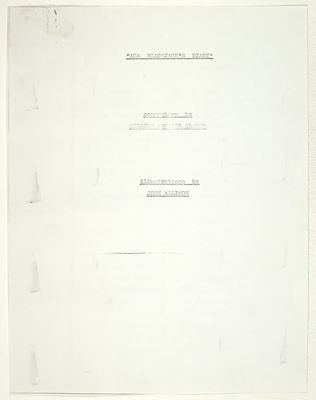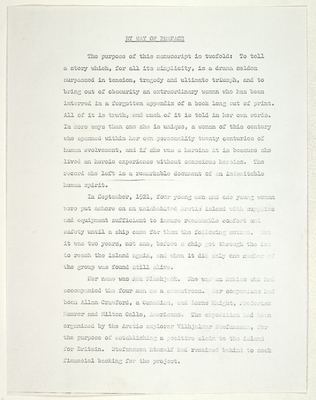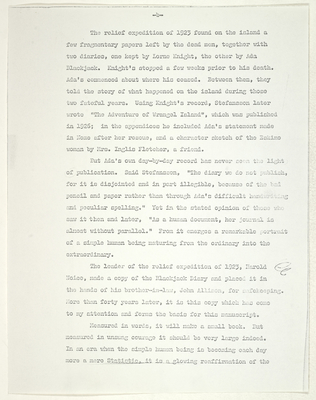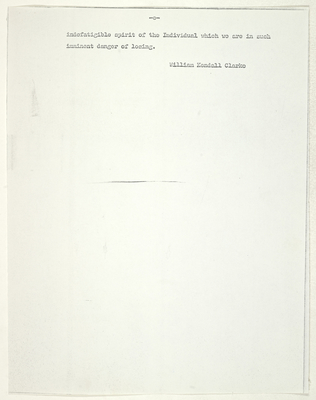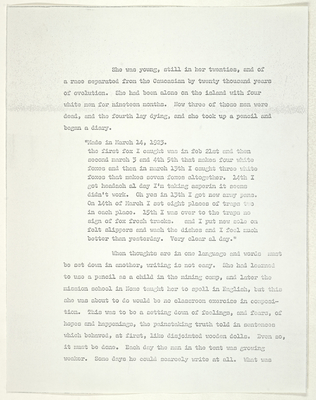Pages
stefansson-wrangel-09-34-001
Last edit 22 days ago by Vibha Vasanthstefansson-wrangel-09-34-002
BY WAY OF PREFACE
The purpose of this manuscript is twofold: To tell a story which, for all its simplicity, is a drama seldom surpassed in tension, tragedy and ultimate triumph, and to bring out of obscurity an extraordinary woman who has been interred in a forgotten appendix of a book long out of print. All of it is truth, and much of it is told in her own words. In more ways than one she is unique, a woman of this century who spanned within her own personality twenty centuries of human evolvement, and if she was a heroine it is because she lived an heroic experience without conscious heroics. The record she left is a remarkable document of an indomitable human spirit.
In September, 1921, four young men and one young woman were put ashore on an uninhabited Arctic island with supplies and equipment sufficient to insure reasonable comfort and safety until a ship came for them the following autumn. But it was two years, not one, before a ship got through the ice to reach the island again, and when it did only one member of the group was found still alive.
Her name was Ada Blackjack. She was an Eskimo who had accompanied the four men as a seamstress. Her companions had been Allan Crawford, a Canadian, and Lorne Knight, Frederick Maurer and Milton Galle, Americans. The expedition had been organized by the Artic explorer Vilhjalmur Stefansson, for the purpose of establishing a positive claim to the island for Britain. Stefansson himself had remained behind to seek financial backing for the project.
stefansson-wrangel-09-34-003
-b-
The relief expedition of 1923 found on the island a few fragmentary papers left by the dead men, together with two diaries, one kept by Lorne Knight, the other by Ada Blackjack. Knight’s stopped a few weeks prior to his death. Ada's commenced about where his ceased. Between then, they told the story of what happened on the island during those two fateful years. Using Knight's record, Stefansson later wrote "The Adventure of Wrangel Island", which was published in 1926; in the appendices he included Ada's statement made in Nome after her rescue, and a character sketch of the Eskimo woman by Mrs. Inglis Fletcher, a friend.
But Ada's own day-by-day record has never seen the light of publication. Said Stefansson, "The diary we do not publish, for it is disjointed and in part illegible, because of the bad pencil and paper rather than through Ada's difficult handwriting and peculiar spelling." Yet in the stated opinion of those who saw it then and later, "As a human document, her journal is almost without parallel." From it emerges a remarkable portrait of a simple human being maturing from the ordinary into the extraordinary.
The leader of the relief expedition of 1923, Harold Noice, made a copy of the Blackjack Diary and placed it in the hands of his brothor-in-law, John Allison, for safekeeping. More than forty years later, it is this copy which has come to my attention and forms the basis for this manuscript.
Measured in words, it will make a small book. But measured in unsung courage it should be very large indeed. In an era when the simple human being is becoming each day more a mere Statistic, it is a glowing reaffirmation of the
stefansson-wrangel-09-34-004
-c-
indefatigible spirit of the Individual which we are in such imminent danger of losing.
stefansson-wrangel-09-34-005
She was young, still in her twenties, and of a race separated from the Caucasian by twenty thousand years of evolution. She had been alone on the island with four white men for nineteen months. Now three of those men were dead, and the fourth lay dying, and she took up a pencil and began a diary.
"Made in . the first fox I caught was in feb 21st and then second march 3 and 4th 5th that makes four white foxes and then in march 13th 1 caught three white foxes that makes seven foxes altogether. 14th I got headach a1 day I'm taking asperin it seems didn't work. Oh yes in 13th I got new army pans. On 14th of March I set eight places of traps two in each place. 15th I was over to the traps no sign of fox fresh tracks. and I put new sole on felt slippers and wash the dishes and I feel much better than yesterday. Very clear al day."
When thoughts are in one language and words must be set down in another, writing is not easy. She had learned to use a pencil as a child in the mining camp, and later the mission school in Nome taught her to spell in English, but this she was about to do would be no classroom exercise in composition. This was to be a setting down of feelings, and fears, of hopes and happenings, the painstaking truth told in sentences which behaved, at first, like disjointed wooden dolls. Even so, it must be done. Each day the man in the tent was growing weaker. Some days he could scarcely write at all. What was
